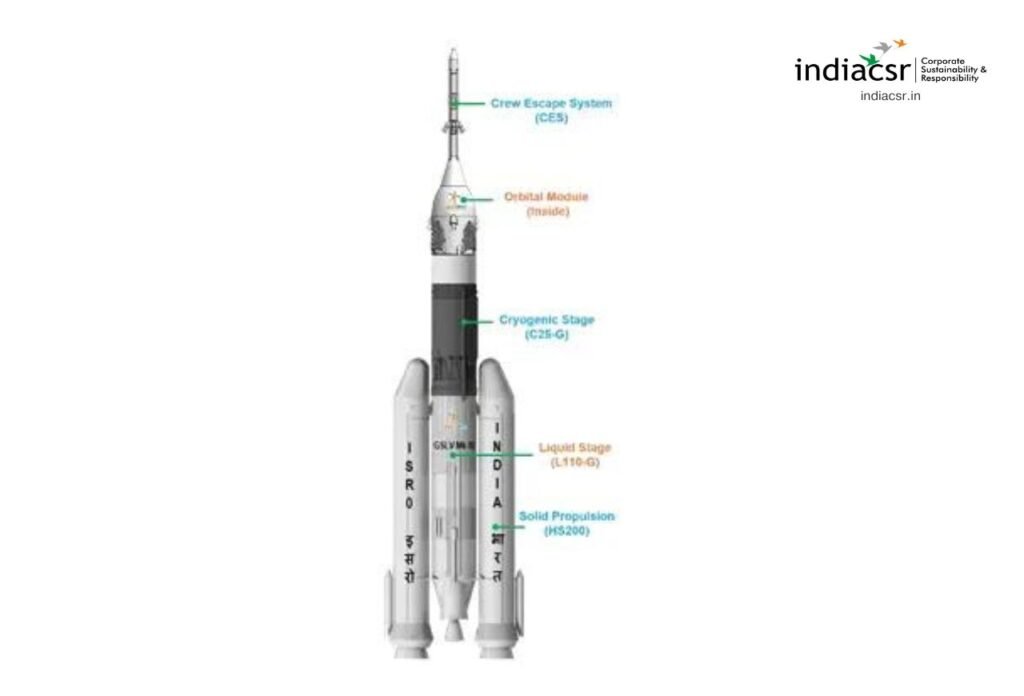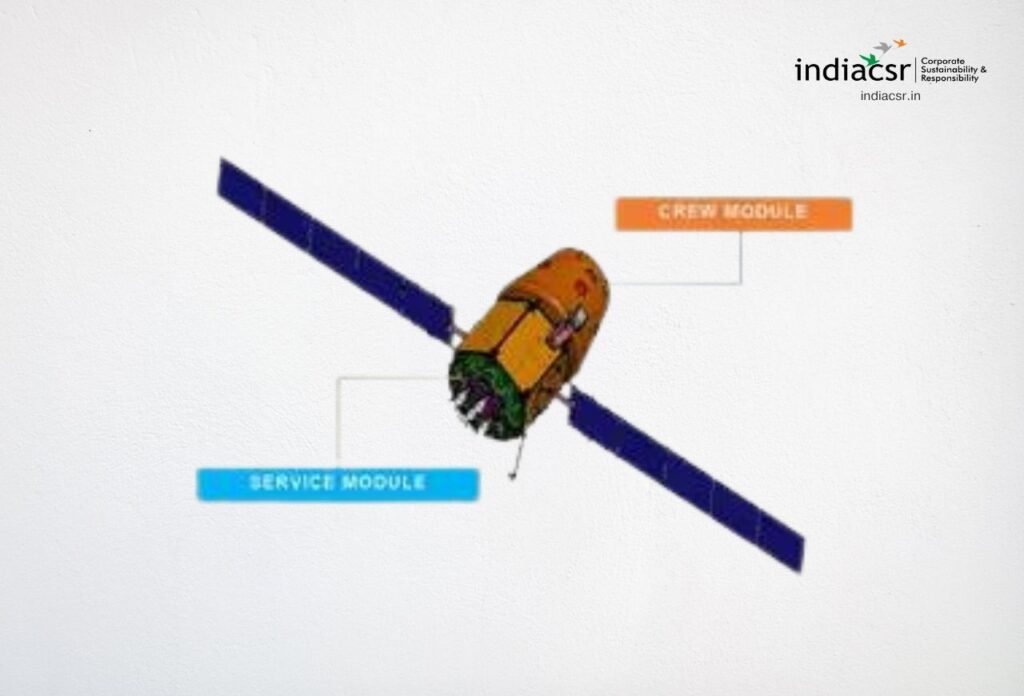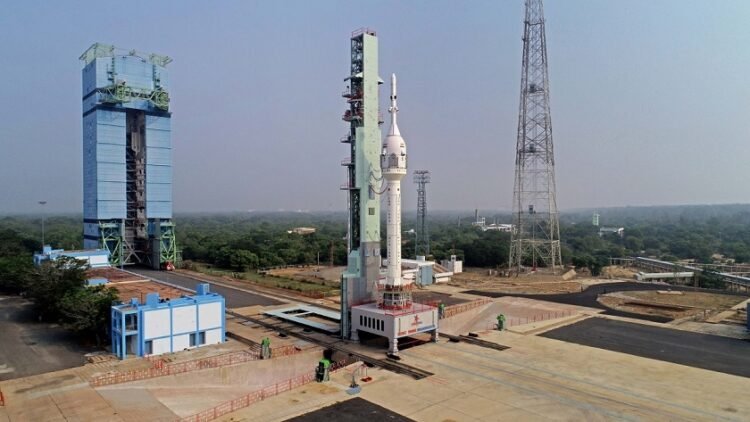Gaganyaan Mission: India’s First Human Space Flight Program
The Gaganyaan Mission is a landmark initiative by the Indian Space Research Organisation (ISRO) aimed at demonstrating India’s capability to undertake human spaceflight. The mission, which is scheduled to launch in 2025, will send a three-member crew to a low Earth orbit (LEO) for a period of up to seven days.
Story Behind Word ‘Gaganayan’
India often chooses cool names for its space missions, either inspired by historical moments or digging deep into the ancient language of Sanskrit. “Gaganayaan” falls in the second category, translating to “Celestial Vehicle” – pretty cool, right?
Gaganyaan
- Gagana (Sanskrit: गगन) – Means “sky,” “celestial,” or “atmosphere.”
- Yāna (Sanskrit: यान) – Means “vehicle,” “craft,” or “vessel.”
- Together, the word “Gaganyaan” translates to “sky vehicle” or “celestial craft.”
Gaganyaan: India’s Space Mission
Gaganyaan is India’s first crewed orbital spacecraft project. It’s a major milestone for the Indian Space Research Organisation (ISRO). The key goals of the Gaganyaan mission are:
- Demonstrate India’s ability to send humans to Low Earth Orbit (LEO).
- Lay a strong foundation for future, more ambitious, sustained human space exploration programs.
***
Philosophy Behind word ‘Gaganayan’
While there isn’t an officially stated “philosophy” behind the name “Gaganayaan,” we can infer some possible ideas based on its meaning and India’s approach to naming space missions:
1. Connection to the Universe: Choosing a Sanskrit word with roots in “sky” and “vehicle” suggests an intent to connect the mission to the vastness of the universe. It reflects India’s aspirations in space exploration and its desire to reach new heights.
2. Continuity with Tradition: India often names its space missions after mythological figures, historical events, or significant scientific discoveries. “Gaganayaan” continues this tradition of drawing inspiration from its rich heritage.
3. Simple and Evocative: The name is short, easy to pronounce, and carries a powerful image. This accessibility resonates with the public and creates a sense of national pride associated with the mission.
4. Reflecting India’s Identity: Choosing a Sanskrit word connects the mission to India’s ancient culture and intellectual tradition. It sends a message of cultural pride and demonstrates India’s contribution to the global scientific endeavor.
Gaganyaan Project
The Gaganyaan project aims to showcase India’s capability in human spaceflight by sending a three-member crew to a 400 km orbit for a three-day mission, followed by a safe return to Earth, landing in the waters off the coast of India.
This ambitious endeavor is realized through a carefully crafted strategy that leverages the domestic expertise and experience of the Indian industry, the intellectual prowess of India’s academic and research institutions, and the most advanced technologies from international partners. Essential to the Gaganyaan mission are the development of several critical technologies, including a human-rated launch vehicle to safely transport the crew into space, a Life Support System to maintain Earth-like conditions for the crew in orbit, provisions for crew emergency escape, and comprehensive crew management plans covering training, recovery, and rehabilitation.
To ensure the mission’s success, a series of precursor missions are set to demonstrate the readiness of these technologies. These preliminary missions encompass the Integrated Air Drop Test (IADT), the Pad Abort Test (PAT), and Test Vehicle (TV) flights. The safety and reliability of all systems will be thoroughly verified through unmanned missions before proceeding with the manned mission.
Human rated LVM3 – HLVM3
The LVM3 rocket, ISRO’s trusted and proven heavy-lift launcher, has been selected for the Gaganyaan mission. This rocket features a combination of solid, liquid, and cryogenic stages. To fulfill the stringent requirements of human spaceflight, all systems within the LVM3 have been adapted and upgraded, resulting in the Human Rated LVM3 (HLVM3). This enhanced version of the rocket is designed to carry the Orbital Module into a targeted Low Earth Orbit at 400 km.

The HLVM3 is equipped with a Crew Escape System (CES), which is powered by a series of rapid-activation, high burn rate solid motors. This system is designed to ensure the Crew Module, along with its occupants, is quickly moved to a safe distance from any potential dangers that could arise either on the launch pad or during the rocket’s ascent.
Orbital Module
The Orbital Module (OM) intended for Earth orbit is composed of a Crew Module (CM) and a Service Module (SM). The OM is furnished with advanced avionics systems, incorporating sufficient redundancy to prioritize human safety.
The CM serves as a habitable space in space for the crew, creating an Earth-like environment. It features a double-walled construction, consisting of a pressurized metallic Inner Structure and an unpressurized External Structure equipped with a Thermal Protection System (TPS). Within the CM, crucial components such as crew interfaces, human-centric products, life support systems, avionics, and deceleration systems are housed. Additionally, it is designed for re-entry to ensure the safety of the crew during descent until touchdown.

The SM is dedicated to providing essential support to the CM while in orbit. This unpressurized structure incorporates a thermal system, propulsion system, power systems, avionics systems, and deployment mechanisms. The SM plays a crucial role in maintaining the functionality and support required for the successful operation of the entire Orbital Module.
Significance of the Gaganyaan Mission
The Gaganyaan Mission is a significant milestone in India’s space program. It will demonstrate the country’s ability to design, develop, and operate a human spaceflight mission. The mission will also pave the way for future Indian missions to space, such as a lunar mission and a space station.
Benefits of the Gaganyaan Mission
The Gaganyaan Mission will have a number of benefits for India. These benefits include:
- Inspiring a new generation of scientists and engineers: The Gaganyaan Mission will inspire a new generation of students to pursue careers in science and engineering. The mission will demonstrate the power of science and technology to achieve great things.
- Boosting India’s technological capabilities: The Gaganyaan Mission will boost India’s technological capabilities. The mission will require the development of new technologies in areas such as spacecraft design, life support systems, and astronaut training.
- Enhancing India’s global standing: The Gaganyaan Mission will enhance India’s global standing. The mission will demonstrate India’s commitment to space exploration and its ability to compete with other leading spacefaring nations.
- Challenges of the Gaganyaan Mission:
The Gaganyaan Mission is a complex and challenging undertaking. Some of the challenges that the mission will face include:
- Developing the necessary technologies: The Gaganyaan Mission will require the development of a number of new technologies. These technologies include a human-rated spacecraft, a launch vehicle capable of carrying humans, and a life support system that can sustain astronauts for up to seven days in space.
- Ensuring the safety of the astronauts: The safety of the astronauts is the top priority of the Gaganyaan Mission. ISRO is taking a number of steps to ensure the safety of the astronauts, such as conducting rigorous training and developing comprehensive safety procedures.
- Meeting the tight schedule: The Gaganyaan Mission is on a tight schedule. ISRO is working hard to meet the deadline of 2025.
Objectives of Gaganyaan Mission
The main objectives of Gaganyaan mission are:
- To demonstrate the capability of designing, developing, launching and operating a human space flight vehicle
- To conduct scientific experiments in microgravity environment and test various technologies for future missions
- To inspire the young generation and foster a culture of innovation and exploration in the country
- To enhance India’s prestige and role in the global space community
Current Status and Future Plans of Gaganyaan Mission
The Gaganyaan mission has been progressing steadily since its announcement by Prime Minister Narendra Modi in 2018. Some of the major milestones achieved so far are:
- Selection and training of four Indian Air Force pilots as potential astronauts
- Development and testing of various subsystems such as crew module, service module, environmental control and life support system, crew escape system, parachute system, etc.
- Establishment of various facilities such as astronaut training centre, mission control centre, launch pad abort facility, etc.
- Signing of agreements with various national and international partners such as Russia, France, Japan, etc. for technical assistance and cooperation
The future plans of Gaganyaan mission include:
- Conducting two unmanned test flights of Gaganyaan spacecraft in 2024 and 2025 to validate its performance and safety
- Sending a humanoid robot named Vyommitra to space in one of the test flights to simulate human presence and behaviour
- Launching the first manned mission of Gaganyaan with three Indian astronauts on board in 2025 using GSLV Mk III rocket from Sriharikota
- Carrying out various experiments and activities in orbit such as biological, physical, material, environmental, etc.
- Returning the crew module with the astronauts to Earth using parachutes and splashdown in the Arabian Sea or Bay of Bengal
The Gaganyaan Mission is a bold and ambitious undertaking that will demonstrate India’s commitment to space exploration. The mission will have a number of benefits for India, and it will inspire a new generation of scientists and engineers. The Gaganyaan Mission is a major step forward in India’s journey to becoming a leading spacefaring nation.
Prime Minister Narendra Modi has announced the names of the four astronauts for India’s first human space flight mission, Gaganyaan. The astronauts are:
1. Group Captain Prasanth Balakrishnan Nair
- Born in 1976 in Nenmara, Kerala.
- Commissioned in the fighter stream of the IAF in December 1998.
- A Sukhoi fighter pilot and a recipient of the ‘Sword of Honour’.
- Has flown a variety of aircraft, including Su-30 MKI, MiG-21, MiG-29, Hawk, Dornier, and An-32.
- Has approximately 3,000 hrs of flying experience.
- Married to Malayalam actress Lena.
2. Group Captain Ajit Krishnan
- An alumnus of the National Defence Academy.
- A recipient of the President’s Gold Medal and Sword of Honour.
- Has around 2,900 hours of flying time.
3. Group Captain Angad Pratap
- Commissioned on December 18, 2004, in the fighter stream of IAF.
- A Flying Instructor and a Test Pilot with approximately 2,000 hours of flying experience.
- Has flown a variety of aircraft including Su-30 MKI, MiG-21, MiG-29, Jaguar, BAe Hawk, Dornier, and An-32.
4. Wing Commander Shubhanshu Shukla
- Born in Lucknow.
- Commissioned in the Indian Air Force on June 17, 2006, in the fighter stream.
- A Fighter Combat Leader and a Test Pilot with around 2,000 hours of flying experience.
These Indian Air Force officers have had extensive experience as test pilots and are currently in training for the mission. The announcement was made at the Vikram Sarabhai Space Centre in Thumba, Kerala. The first unmanned Gaganyaan-1 mission, a test flight to check the technology readiness for the final mission, is scheduled to take off by the end of 2024. The manned mission, which will fly a three-membered crew into a low earth orbit at an altitude of 400 km for a period of three days, is scheduled later.
Also Read: Gaganyaan Mission: The Definition, Characteristics, Role and Impact Explained



















